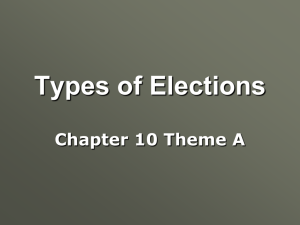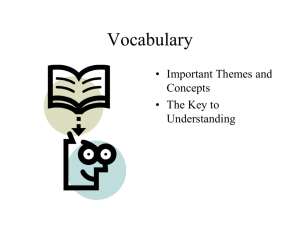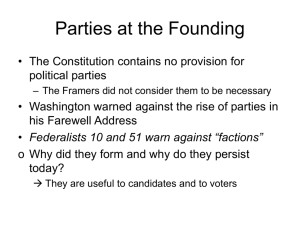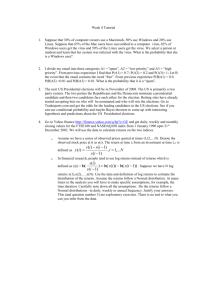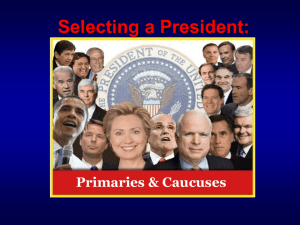Types of Elections
advertisement
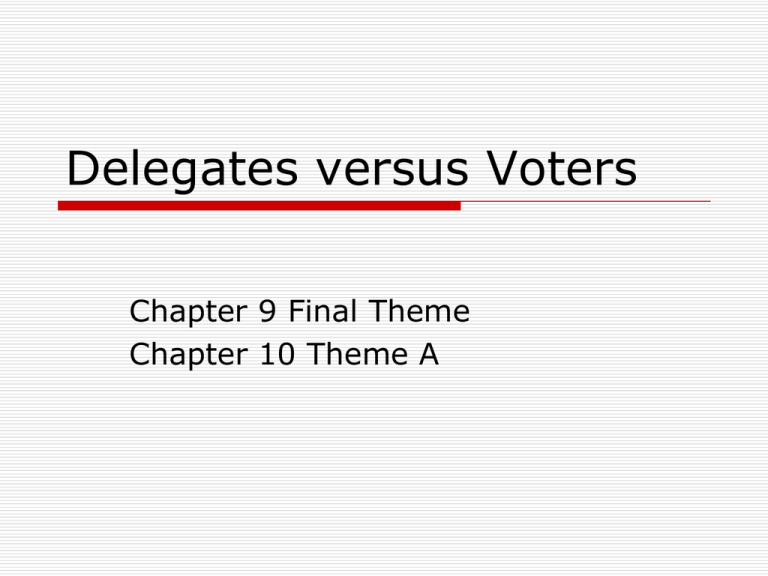
Delegates versus Voters Chapter 9 Final Theme Chapter 10 Theme A Alternative Voting Systems Hand back paragraphs on which system is best. Discuss and debate. Award winner their “prize.” 4 Votes 5 Votes 1 Vote 4 Votes Others: 3 Votes Proportional, 3 Votes Transferrable Nominating a President By tradition, party "out of power"-the one not holding the presidency-holds its convention first. (RNC 7/18 in Cleveland, DNC 7/25 in Philadelphia) Two contrary forces: Party's desire to win motivates it to seek an appealing candidate, but its desire to keep dissidents in party forces a compromise with more extreme views Are the delegates representative of the voters? No! More liberal Dems., More conservative Reps. Why this disparity? Political elites, Minorities overrepresented, growing number of independents Who votes in primaries? Primaries now more numerous and more decisive Stevenson (1952) & Humphrey (1968) won nomination without entering any primaries 2012: 40 primaries & 20 caucuses (some sts. with both) Little ideological difference between primary voters and rank-and-file party voters Caucus: meeting of party followers at which delegates are picked Only most dedicated partisans attend Often choose most ideological candidate: Jackson, Robertson in 1988; Obama, Huckabee in 2008 Who are the new delegates? Today's delegates are issue-oriented activists Advantages of new system Increased chance for activists within party Decreased probability of their bolting from the party Disadvantage May nominate presidential candidates unacceptable to voters, esp. moderates Parties versus Voters Democrats: have won more congressional elections than presidential contests Candidates are out of step with average voters on social and taxation issues Delegates out of step with average voter... is there's a connection? Rank-and-file Democrats and Republicans differ on many political issues but differences are usually small Delegates of the parties though widely differ on political issues—See Chart! Primary voters are more consistent… The Candidate’s Dilemma Candidates need to correspond with views of average citizens--But candidates must often play to the ideological extremes to win delegate support How do we get candidates that appeal to both? Can we? Introduction to Elections What are the 2 phases of all types of elections? What are the steps in getting nominated? How are US elections different from those in Europe? Primaries vs. General Elections Explain the difference in the type of elections. Why might you need to prepare differently for these? What factors are important to party members in primaries? http://www.youtube.com/watch?v=OB5MgtSUTlc Explain the differences in closed, open, blanket, & runoff primaries. NC’s Presidential primary is a binding presidential preference type. What does that mean? What are the alternatives? The Iowa Caucuses Why does the text refer to the Democratic caucus as “a cross between musical chairs and fraternity pledge week?” How can primaries and caucuses come back to haunt a Presidential candidate? Explain “flip-flopping!” http://www.livingroomcandidate.org/commercials/2004 How does the balancing act of winning the nomination cause “clothespin voting?” Presidential vs. Congressional Elections Presidential more competitive Lower voter turnout in midterm elections Congressional members more able to serve constituency Presidential vs. Congressional Elections Congressional candidates can campaign against “Washington” Blame President and hold him accountable Presidents rarely can duck responsibility because they are seen as the “Leader of the Free World” Congressional members are more affected by party’s economic policies Presidential vs. Congressional Elections Power of Coattails declining How will Obama’s popularity affect next year’s elections? How did his popularity affect Republicans running for Congress in 2014? How did this affect Democrats running for Congress in 2014? Running for President Decisions Getting mentioned Who is being mentioned? Setting aside time to run Raising money Organizing a staff Defining a Strategy & Themes Running for President Strategy: 1. What tone? 2. What theme? 3. What should the timing be? Front-loading? Optimistically cautious? 4. Whom to target? Running for Congress Why do incumbents win so often? 4 issues in deciding representation in HOR: Est. the total size of HOR (Congress) (1911) Reapportionment (Congress) (Since 1929) Determining size of districts in state (State legis.) Determine shape & location of districts (St. legis.) Gerrymandering and mal-apportionment Define each term How has the US Supreme Court become the referee? Discuss cases Types of Issues What is the difference between a position issue and valence issue? How can position issues lead to party realignment? How did valence issues help shape the 2008, 2012 & 2014 elections? Why have valence issues become more important today? Give examples. In a close election, what drives who wins? Source: MSNBC The media & elections How has the media shaped the last few elections? Candidates must be “telegenic” and well-spoken Sound bytes have replaced long speeches The use of social media has exploded The cost of elections had risen greatly Assignment Complete chapter 10 reading, pp. 249-66. Due tomorrow. Outline each of the following: Sources of money Campaign finance rules SCOTUS interpretations of finance rules What factors don’t and which do decide elections The effects elections have on policy


